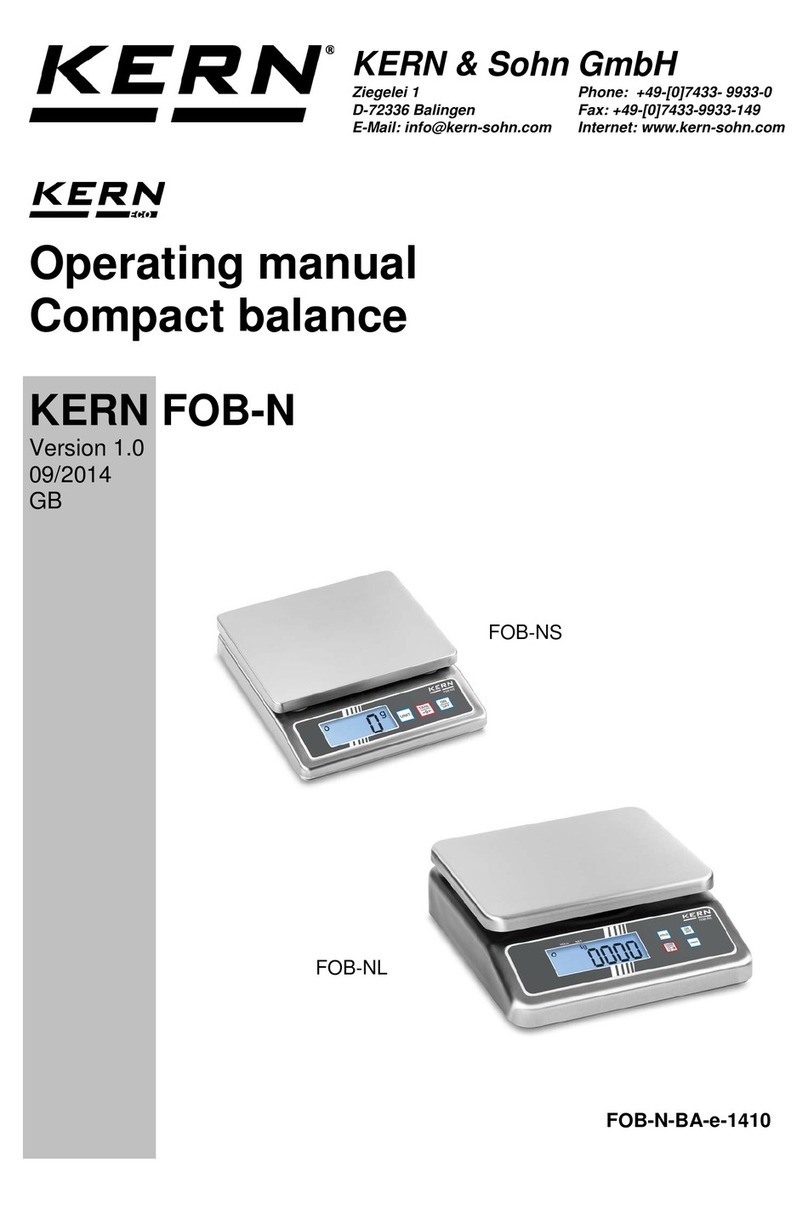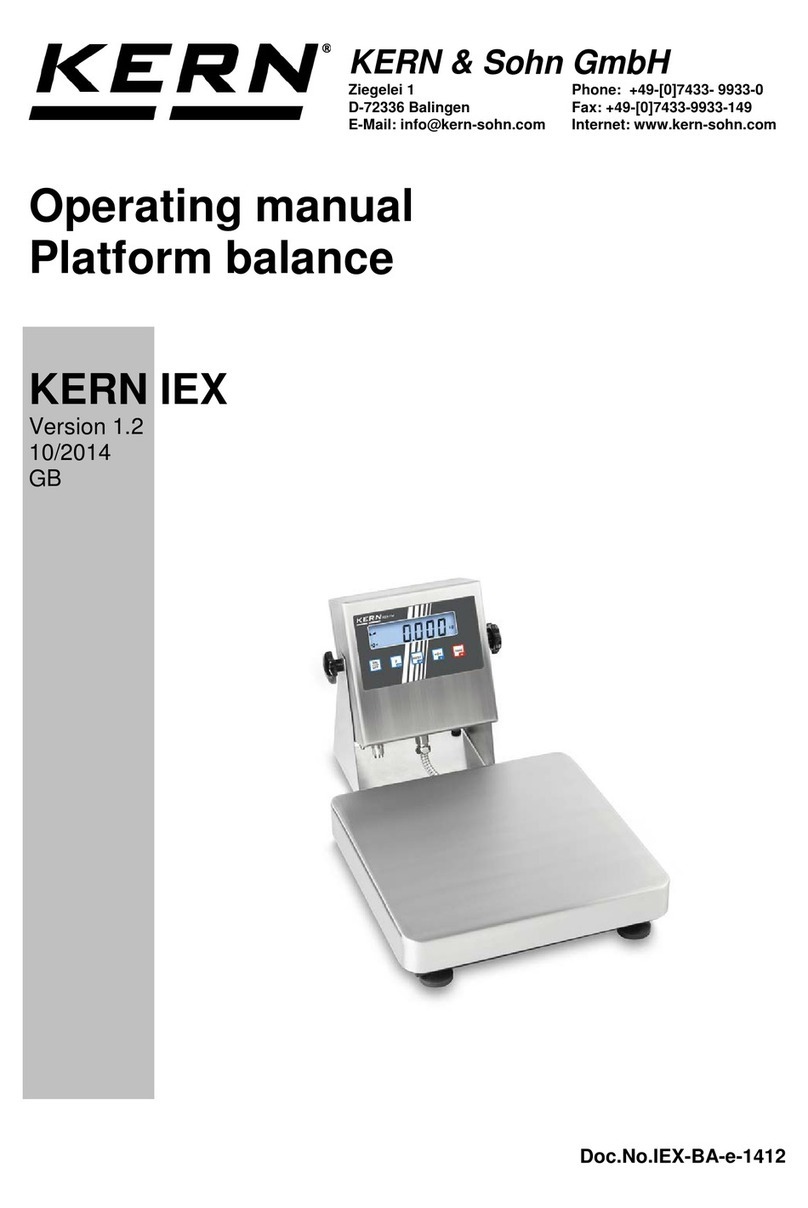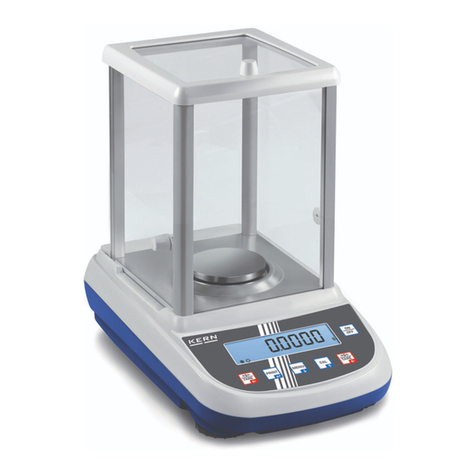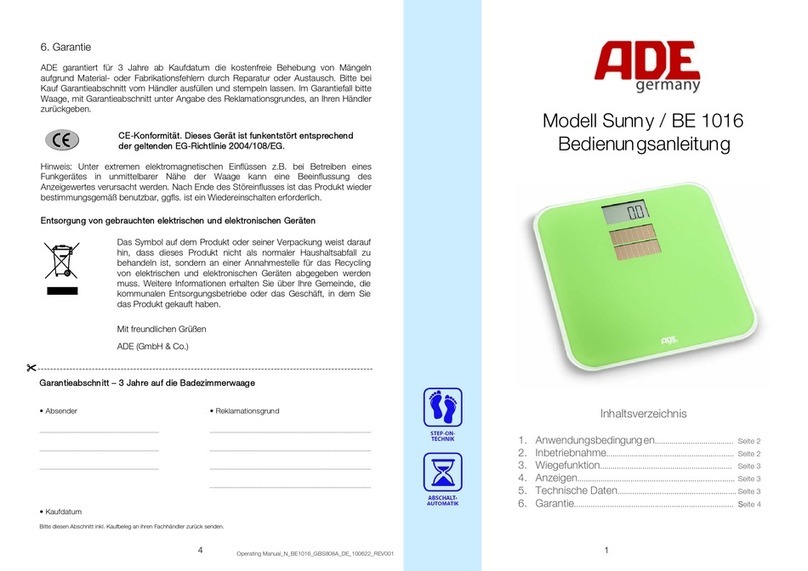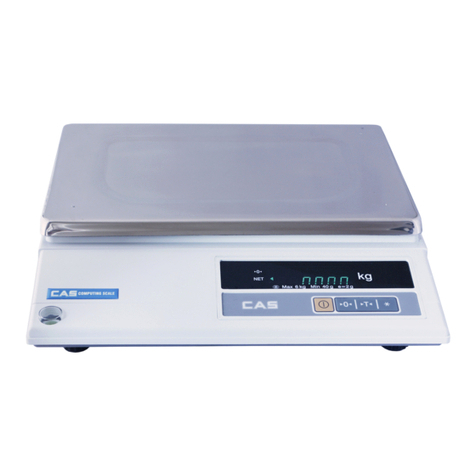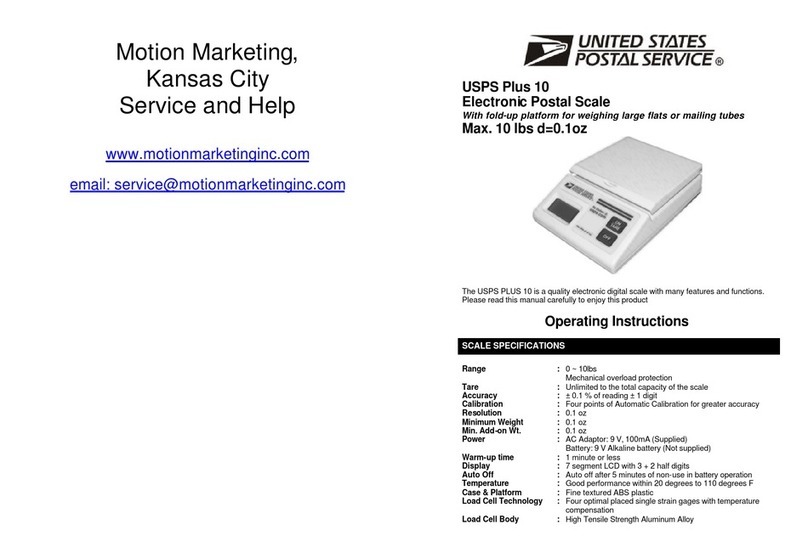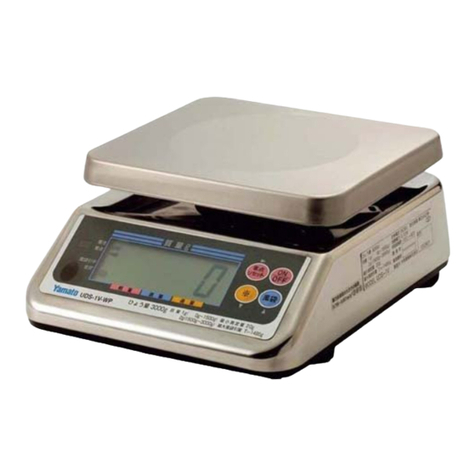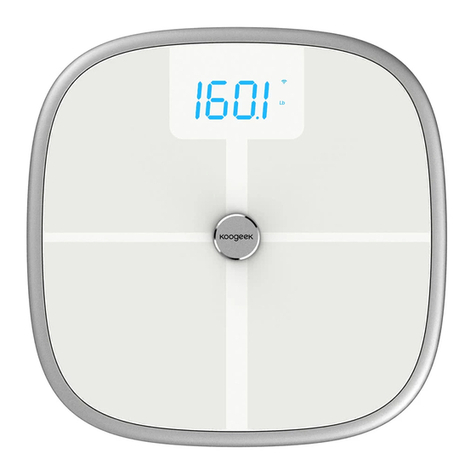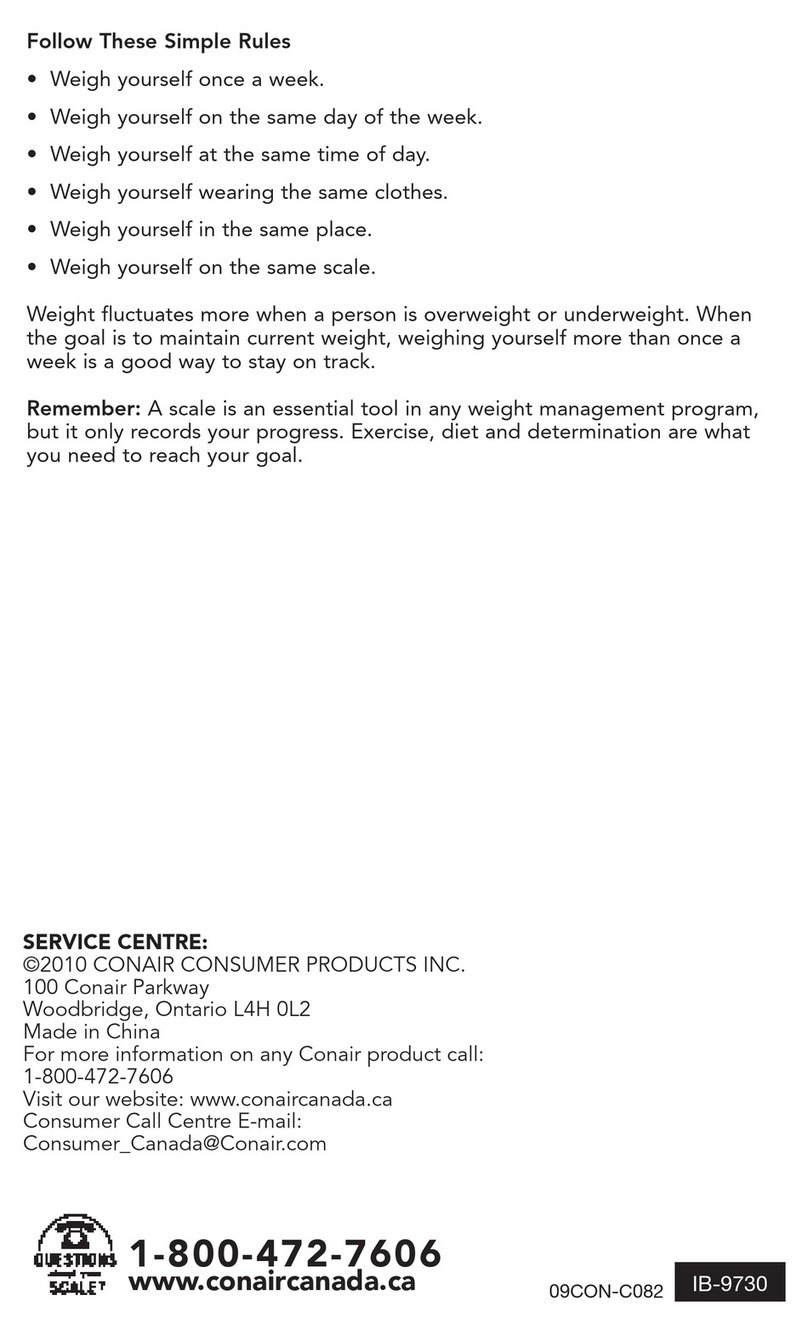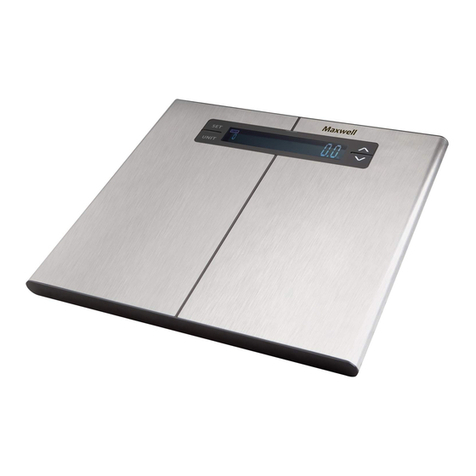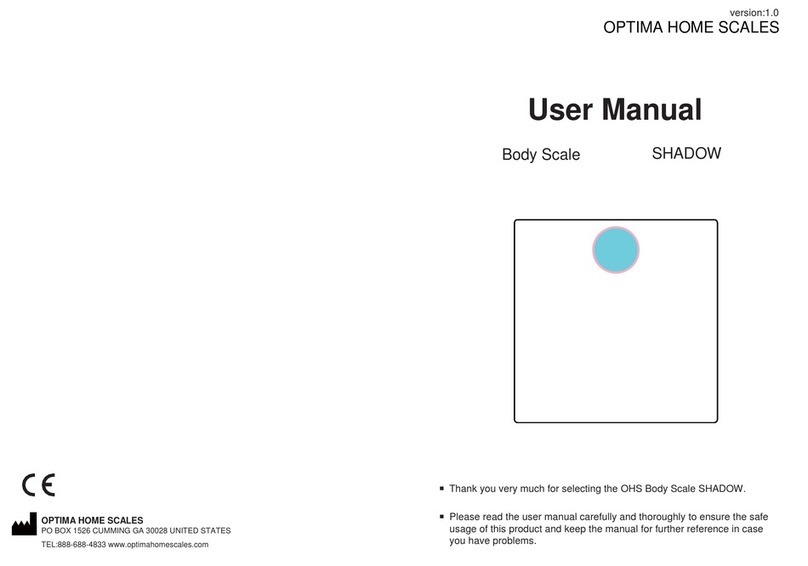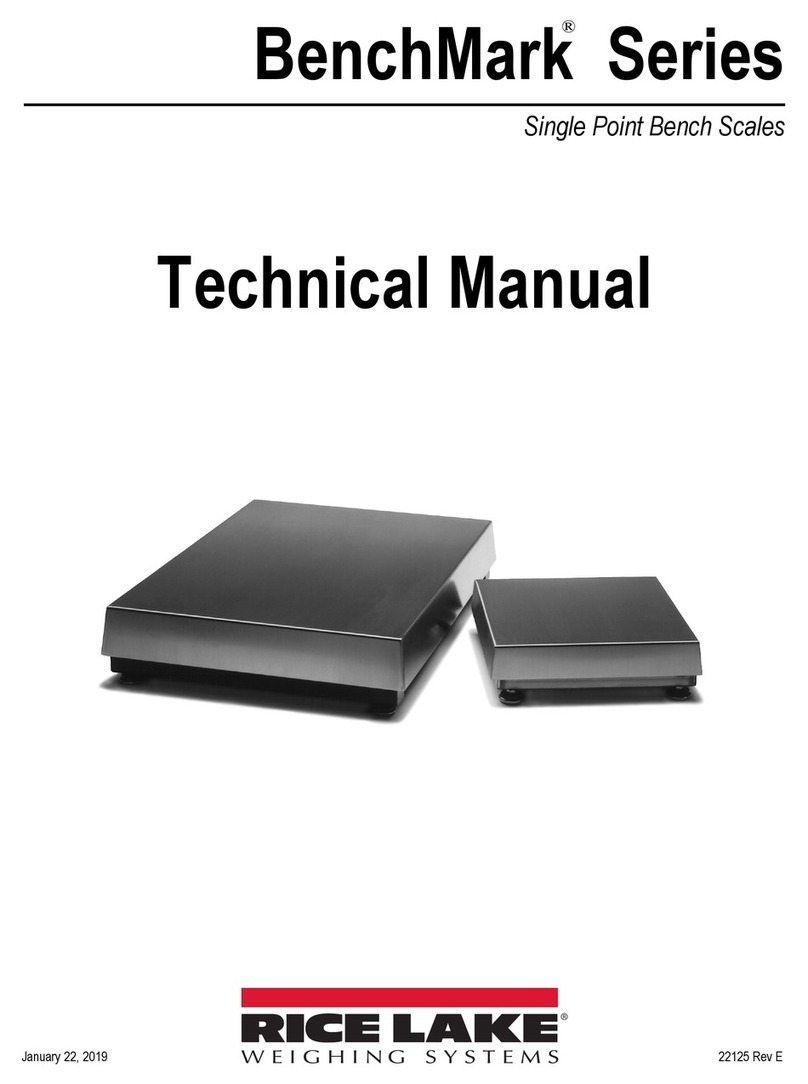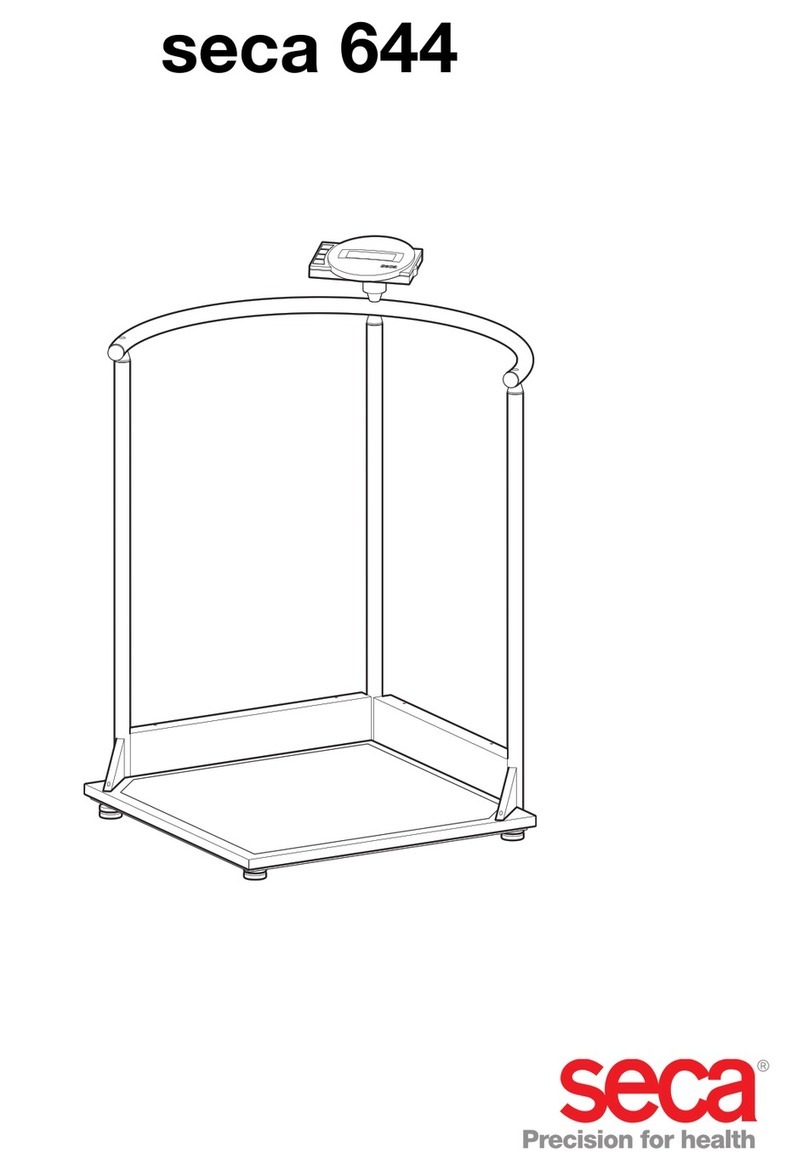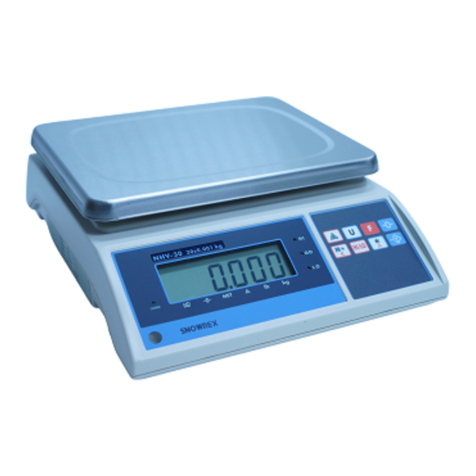KERN FES 17K-4 User manual

KERN & Sohn GmbH
Phone: +49-[0]7433- 9933-0
Fax: +49-[0]7433-9933-149
Internet: www.kern-sohn.com
Operating instructions
Precision balance
KERN FES / FEJ
Version 1.0
2022-06
GB
TFES_TFEJ-BA-e-2210

1 TFES_TFEJ-BA-e-2210
GB
KERN FES / FEJ
Version 1.0 2022-06
Operating instructions
Precision balance
Contents
1Technical data................................................................................................ 4
2Declaration of conformity ............................................................................. 6
3Appliance overview ....................................................................................... 7
3.1 Components.............................................................................................................................. 7
3.2 Keyboard................................................................................................................................... 8
3.3 Display....................................................................................................................................... 9
3.3.1 Explanation of the display text.................................................................................................. 10
4Basic Information (General)........................................................................ 11
4.1 Proper use............................................................................................................................... 11
4.2 Improper Use .......................................................................................................................... 11
4.3 Warranty.................................................................................................................................. 11
4.4 Monitoring of Test Resources............................................................................................... 12
5Basic Safety Precautions............................................................................ 12
5.1 Pay attention to the instructions in the Operation Manual ................................................ 12
5.2 Personnel training.................................................................................................................. 12
6Transport and storage................................................................................. 12
6.1 Testing upon acceptance ...................................................................................................... 12
6.2 Packaging / return transport ................................................................................................. 12
7Unpacking, Installation and Commissioning............................................. 13
7.1 Installation Site, Location of Use.......................................................................................... 13
7.2 Unpacking, Scope of delivery ............................................................................................... 13
7.3 Placing..................................................................................................................................... 15
7.3.1 Mounting the weighing platform with terminal.......................................................................... 15
7.3.2 Mounting the weighing platform without terminal..................................................................... 17
7.4 Levelling.................................................................................................................................. 18
7.5 Mains connection ................................................................................................................... 18
7.5.1 Turning On the Power .............................................................................................................. 19
7.6 Initial Commissioning............................................................................................................ 19
7.7 Connection of peripheral devices......................................................................................... 19
8Menu ............................................................................................................. 20
8.1 Menu overview........................................................................................................................ 20
8.2 Navigation in the menu.......................................................................................................... 24
9Basic Operation ........................................................................................... 25
9.1 Turn on/off............................................................................................................................... 25
9.2 Zeroing .................................................................................................................................... 26
9.3 Taring....................................................................................................................................... 26
9.3.1 Deleting the tare value.............................................................................................................. 27
9.4 Setting the weighing unit....................................................................................................... 28
9.4.1 Supported weighing units......................................................................................................... 29
9.5 Selection of a weighing application ..................................................................................... 29
9.6 Simple weighing ..................................................................................................................... 30
9.7 Changing the display and function keys ............................................................................. 30
9.8 Numeric entry ......................................................................................................................... 31
10 Piece counting ............................................................................................. 33
10.1 Select the piece counting function....................................................................................... 33

TFES_TFEJ-BA-e-2210 2
10.2 Actual value setting method: Weighing the reference sample quantity........................... 34
10.3 Numerical input of the piece weight..................................................................................... 35
10.4 Other functions....................................................................................................................... 35
11 Percent weighing......................................................................................... 37
11.1 Selecting the percent weighing function............................................................................. 37
11.2 Other functions....................................................................................................................... 38
12 Coefficient multiplication............................................................................ 40
12.1 Selecting the coefficient multiplication function ................................................................ 40
12.2 Apply coefficient multiplication............................................................................................ 40
12.3 Other functions....................................................................................................................... 41
13 Weighing with tolerance range................................................................... 42
13.1 Selection of weighing function with tolerance range......................................................... 43
13.2 Set discrimination condition................................................................................................. 44
13.3 Setting the discrimination range .......................................................................................... 44
13.4 Set discrimination method .................................................................................................... 44
13.5 Set acoustic signal................................................................................................................. 45
13.6 Set relay output control......................................................................................................... 45
13.7 Setting the tolerance values.................................................................................................. 45
14 Totalizing...................................................................................................... 48
14.1 Select the Totalizing function ............................................................................................... 48
14.2 Set totalizing method ............................................................................................................. 49
14.3 Using the totalizing function................................................................................................. 49
14.3.1 TOTAL-Adding ..................................................................................................................... 49
14.3.2 NET-Adding.......................................................................................................................... 50
14.3.3 Display or clear the total sum:.............................................................................................. 50
15 PRE-TARE .................................................................................................... 51
15.1 Storing PRE-TARE values ..................................................................................................... 51
15.2 Activate and deactivate stored PRE-TARE values.............................................................. 52
15.3 Exit PRE-TARE mode............................................................................................................. 53
16 Settings for operation and operating behavior......................................... 54
16.1 Setting the short commands for weighing applications .................................................... 54
16.2 Assigning the function keys ................................................................................................. 55
16.3 Stabilisation waiting time ...................................................................................................... 56
16.4 Bar graph display ................................................................................................................... 56
16.5 Acoustic signal....................................................................................................................... 57
16.6 Background lighting............................................................................................................... 58
16.7 Stability settings..................................................................................................................... 58
16.8 Reaction settings.................................................................................................................... 59
16.9 Zero-Tracking.......................................................................................................................... 59
16.10 Simple SCS (Self Counting System) ................................................................................ 60
16.10.1 Enabling / disabling Simple SCS ......................................................................................... 60
16.10.2 Using Simple SCS................................................................................................................ 60
16.11 Multi-range mode ............................................................................................................... 61
16.12 Automatic switch-off function .......................................................................................... 62
17 User administration and access rights...................................................... 63
17.1 User administration................................................................................................................ 63
17.1.1 Activate / deactivate password control................................................................................. 63
17.1.2Assign passwords ................................................................................................................ 64
17.2 Logging a user on to the scale ............................................................................................. 64
17.3 Managing access rights......................................................................................................... 65
17.3.1 Lock keys ............................................................................................................................. 65
17.3.2 Lock menu............................................................................................................................ 66
17.3.3 Unlock all access locks ........................................................................................................ 66
17.4 Set short commands and functions for users..................................................................... 66
18 System Settings........................................................................................... 67
18.1 Call System Settings.............................................................................................................. 67

3 TFES_TFEJ-BA-e-2210
18.2 Balance identification number.............................................................................................. 67
18.3 Date display format ................................................................................................................ 68
18.4 Date and time.......................................................................................................................... 68
18.5 Output language..................................................................................................................... 68
18.6 Readability .............................................................................................................................. 69
18.7 Adjustment with internal weight at power-up...................................................................... 69
18.7.1 Activate internal adjustment at power-up............................................................................. 69
18.7.2 Perform internal adjustment................................................................................................. 70
18.8 Output of the adjustment test result .................................................................................... 70
18.9 Automatic power on when connected to mains.................................................................. 70
18.10 Restore last tare value....................................................................................................... 71
18.11 Restore factory settings.................................................................................................... 72
19 Adjustment................................................................................................... 73
19.1 Adjustment with external weight .......................................................................................... 74
19.1.1 Performing the external adjustment..................................................................................... 74
19.1.2 Adjustment test with external weight.................................................................................... 75
19.2 Adjustment with internal weight........................................................................................... 76
19.2.1 Performing the internal adjustment...................................................................................... 77
19.2.2 Adjustment test with internal weight..................................................................................... 77
19.3 Setting the adjustment reminder .......................................................................................... 77
19.4 Position of the adjustment switches and seal marks......................................................... 78
20 Verification ................................................................................................... 79
21 Interfaces...................................................................................................... 80
21.1 RS-232C interface for data input and output....................................................................... 80
21.1.1 Technical data...................................................................................................................... 80
21.1.2 Interface cable...................................................................................................................... 81
21.2 RS232C interface for data output ......................................................................................... 82
21.3 Data Output Formats (CSP)................................................................................................... 82
21.3.1 Data composition ................................................................................................................. 82
21.3.2 Data description ................................................................................................................... 83
21.4 Data output formats (CBM).................................................................................................... 85
21.4.1 Data composition ................................................................................................................. 85
21.4.2 Data description ................................................................................................................... 86
21.5 Data input................................................................................................................................ 88
21.5.1 Input format 1....................................................................................................................... 88
21.5.2 Input format 2....................................................................................................................... 89
21.6 Response formats .................................................................................................................. 90
21.6.1 A00/Exx Format ................................................................................................................... 90
21.6.2 ACK/NAK Format................................................................................................................. 91
21.7 Communication settings........................................................................................................ 91
21.7.1 Activate / deactivate the RS232-C interface........................................................................ 91
21.7.2 Adjust communication settings............................................................................................. 92
22 Servicing, maintenance, disposal .............................................................. 96
22.1 Cleaning .................................................................................................................................. 96
22.2 Servicing, maintenance ......................................................................................................... 96
22.3 Disposal................................................................................................................................... 96
23 Instant help for troubleshooting................................................................. 97
23.1 Error messages ...................................................................................................................... 98

TFES_TFEJ-BA-e-2210 4
1 Technical data
KERN
FES 17K-4
FES 33K-4
FES 62K-4D
Item no./ Type
TFES 17K-4-A
TFES 33K-4-A
TFES 62K-4D-A
Readability (d)
0.1 g
0.1 g
0.1 g, 1 g
Weighing range
(max)
17 kg
33 kg
6.2 kg, 62 kg
Reproducibility
0.1 g
0.1 g
0.1 g, 1 g
Linearity
0.3 g
0.3 g
0.3 g, 3 g
Stabilization time
3 s
Recommended
adjustment weight,
not added (Category)
10 kg (F1)
5 kg (F1)
20 kg (E2);
10 kg (E2)
50 kg (F1)
Warm-up time
2 h
Weighing Units
g, kg, ct, lb, oz, ozt, dwt, mom, tlh, tls, tlt, tola
Smallest part weight
during piece counting
100 mg (under lab conditions*)
1 g (under normal conditions**)
Reference unit
weights at piece
count
5, 10, 30, 50, 100, free
Weighing plate,
stainless steel
400 x 350 x 150 mm
Dimensions of the
housing (B x D x H)
[mm]
350 x 520 x 170
Net weight (kg)
18 kg
Permissible
ambient condition
5 °C to + 35 °C
Humidity of air
80 %
Power supply unit
input voltage
AC 100-240 V, 50/60Hz
Scale input voltage
12 V, DC
1.0 A
Interfaces
RS-232
Degree of pollution
2
Overvoltage category
Category II
Metres in height
Up to 2000 m
Place of installation
In sealed rooms only

5 TFES_TFEJ-BA-e-2210
KERN
FEJ 17K-4M
FEJ 33K-4M
FEJ 62K-4DM
Item no./ Type
TFEJ 17K-4M-A
TFEJ 33K-4M-A
TFEJ 62K-4DM-A
Readability (d)
0.1 g
0.1 g
0.1 g, 1 g
Weighing range
(max)
17 kg
33 kg
6.2 kg, 62 kg
Minimum load (Min)
5 g
Verification value (e)
1 g
Verification class
II
Reproducibility
0.1 g
0.1 g
0.1 g, 1 g
Linearity
0.3 g
0.3 g
0.3 g, 3 g
Stabilization time
3 s
Recommended
adjustment weight,
not added (Category)
internal
Warm-up time
2 h
Weighing Units
g, kg, ct
Smallest component
weight for piece
counting
100 mg (under lab conditions*)
1 g (under normal conditions**)
Reference unit
weights at piece
counting
5, 10, 30, 50, 100, free
Weighing plate,
stainless steel
400 x 350 x 150 mm
Dimensions caisse
(l x L x h) [mm]
350 x 520 x 170
Net weight (kg)
19 kg
Permissible
ambient condition
5 °C to + 35 °C
Humidity of air
80 %
Power supply unit
input
voltage
AC 100-240 V, 50/60Hz
Scale input
voltage
DC 12 V,
1.0 A
Interfaces
RS-232
Degree of pollution
2
Overvoltage category
Category II
Metres in height
Up to 2000 m
Place of installation
In sealed rooms only

TFES_TFEJ-BA-e-2210 6
* Smallest component weight for piece counting - under lab conditions:
➢There are ideal ambient conditions for high-resolution counting
➢The parts to be counted are not scattered
** Smallest component part for piece counting –under normal conditions:
➢There are unsteady ambient conditions (draft, vibrations)
➢The parts to be counted are being scattered
2 Declaration of conformity
The current EC/EU Conformity declaration can be found online in:
www.kern-sohn.com/ce
For verified weighing scales (= weighing scales assessed for
conformity) the declaration of conformity is included in the scope of
delivery.

7 TFES_TFEJ-BA-e-2210
3 Appliance overview
3.1 Components
Pos.
Designation
1
Terminal
2
Weighing unit
3
Weighing plate
4
Bubble level
5
Levelling screw
6
Mains connection
7
Scale cable
8
RS-232C interface
9
Connection for peripheral devices
10
Cover hook for underfloor weighing
1
3
2
4
5
7
8
6
10
9

TFES_TFEJ-BA-e-2210 8
3.2 Keyboard
Button
Designation
Description
[ON/OFF]
Switch-on
Switch off (hold down for about 2 seconds)
[MENU]
Open and close menu
Cancel input and return to menu
[PRINT]
Data export to external device
[ZERO]
Zeroing
[TARE]
Taring
[F1]
Select mode, function and element
Select menu items or increase numeric entry
by 1
[F2]
Select mode, function and element
Select menu items or decrease numerical
input by 1
[F3]
Select mode, function and element
Switch to higher menu level or select digit
[F4]
Select mode, function and element
Move to lower menu level or select digit
To confirm or exit the current selection
Return to the menu or into weighing mode

9 TFES_TFEJ-BA-e-2210
3.3 Display
No.
Display
Designation
Description
1
Minus
Displays negative values
2
Stability display
Is displayed when the weight
value is stable
3
Indicator “zero display”
Displays zero position
4
7-segment
To display the weight value and
characters
5
Charge status display
Displayed during battery
operation
6
Indicator „Data output"
Displayed when scale is sending
data to external device
7
Display gross weight value
Displays gross weight
8
Display net weight value
Displayed when tare weight or
PRE-TARE value has been
subtracted
9
Preset tare
Displayed when the PRE-TARE
value has been subtracted
10
Gram
Shows unit „Gramm“
11
Kilogram
Shows unit „Kilogramm“
12
16-segment message / unit
To display various messages and
units
13
Function key action
Displayed when function keys are
active
14
Colon
To display the date and time
15
Asterisk
To display the standby status or in
the totalizing function as an
indication that weight value can
be added.
16
Bar graph display
Indicates how much the weighing
plate is loaded with respect to the
maximum weighing range
Indicates the progress of internal
adjustment
17*
Marking of non-verification-
relevant digits
Is displayed for digits that are not
relevant to verification
* No. 17 is displayed only on verified balances and scales

TFES_TFEJ-BA-e-2210 10
3.3.1 Explanation of the display text
space
minus / hyphen
comma
point
asterisk
slash
left arrow
right arrow
space
plus
minus / hyphen
comma
point
percent
Degree Celsius

11 TFES_TFEJ-BA-e-2210
4 Basic Information (General)
4.1 Proper use
The balance you purchased is intended to determine the weighing value of material
to be weighed. It is intended to be used as a “non-automatic balance”, i.e. the
material to be weighed is manually and carefully placed in the center of the weighing
pan. The weighing result can be read off once a stable weight value has been
reached.
4.2 Improper Use
•Our balances are non-automatic balances and not provided for use in dynamic
weighing processes. However, the balances can also be used for dynamic
weighing processes after verifying their individual operative range, and here
especially the accuracy requirements of the application.
•Do not leave permanent load on the weighing pan. This may damage the
measuring system.
•Impacts and overloading exceeding the stated maximum load (max) of the
balance, minus a possibly existing tare load, must be strictly avoided. Balance
may be damage by this.
•Never operate the balance in explosive environment. The serial version is not
explosion protected.
•The structure of the balance may not be modified. This may lead to incorrect
weighing results, safety-related faults and destruction of the balance.
•The balance may only be used according to the described conditions. Other
areas of use must be released by KERN in writing.
4.3 Warranty
The warranty becomes void if:
•Our conditions in the operation manual are ignored
•The appliance is used beyond the described uses
•The appliance is modified or opened
•Mechanical damage or damage by media, liquids, natural wear and tear
•The appliance is improperly set up or incorrectly electrically connected
•The measuring system is overloaded

TFES_TFEJ-BA-e-2210 12
4.4 Monitoring of Test Resources
In the framework of quality assurance the measuring-related properties of the
balance and, if applicable, the test weight, must be checked regularly. The
responsible user must define a suitable interval as well as type and scope of this test.
Information is available on KERN’s home page (www.kern-sohn.com) with regard to
the monitoring of balance test substances and the test weights required for this. In
KERN's accredited DKD calibration laboratory test weights and balances may be
calibrated (return to the national standard) fast and at moderate cost.
5 Basic Safety Precautions
5.1 Pay attention to the instructions in the Operation Manual
Carefully read this operation manual before setup and
commissioning, even if you are already familiar with KERN balances.
5.2 Personnel training
The appliance may only be operated and maintained by trained staff.
6 Transport and storage
6.1 Testing upon acceptance
When receiving the appliance, please check packaging immediately, and the
appliance itself when unpacking for possible visible damage.
6.2 Packaging / return transport
Keep all parts of the original packaging for a possibly required
return.
Only use original packaging for returning.
Prior to dispatch disconnect all cables and remove loose/mobile
parts.
Reattach possibly supplied transport securing devices.
Secure all parts such as the glass wind screen, the weighing
plate, power unit etc. against shifting and damage.

13 TFES_TFEJ-BA-e-2210
7 Unpacking, Installation and Commissioning
7.1 Installation Site, Location of Use
The balances are designed in a way that reliable weighing results are achieved in
common conditions of use.
You will work accurately and fast, if you select the right location for your balance.
On the installation site observe the following:
•Place the balance on a firm, level surface.
•Avoid extreme heat as well as temperature fluctuation caused by installing
next to a radiator or in the direct sunlight.
•Protect the balance against direct draughts due to open windows and doors.
•Avoid jarring during weighing.
•Protect the balance against high humidity, vapors and dust.
•Do not expose the device to extreme dampness for longer periods of time.
Non-permitted condensation (condensation of air humidity on the appliance)
may occur if a cold appliance is taken to a considerably warmer environment.
In this case, acclimatize the disconnected appliance for ca. 2 hours at room
temperature.
•Avoid static charge of goods to be weighed or weighing container.
•Do not operate in areas with hazard of explosive material or in potentially
explosive atmospheres due to materials such as gasses, steams, mists or
dusts.
•Keep away chemicals (such as liquids or gasses), which could attack and
damage the balance inside or from outside.
•Keep IP protection of the device.
•In the event of the occurrence of electromagnetic fields, static charges (e.g.,
when weighing / counting plastic parts) and unstable power supply, large
display deviations (incorrect weighing results, as well as damage to the scale)
are possible. In that case, the location must be changed.
7.2 Unpacking, Scope of delivery
Remove device and accessories from packaging, remove packaging material and
install the device at the planned work place. Check if that there has been no damage
and that all items of delivery scope are present.

TFES_TFEJ-BA-e-2210 14
Scope of delivery:
1. Weighing platform
with terminal
2. Cable
compartment
cover
3. Cover wall bracket
4. Wall bracket
5. Power supply set
6. Operating
instructions

15 TFES_TFEJ-BA-e-2210
7.3 Placing
The correct location is a crucial factor in the accuracy of the weighing
results of high-resolution precision balances (see chapter 7.1).
7.3.1 Mounting the weighing platform with terminal
1. Remove the weighing plate from the scale
2. Loosen knobs on wall mounting bracket and remove mounting plates
3. Hook wall mounting bracket onto cable compartment from above
4. Hook the fastening plates in front of the cable compartment and tighten
them on the wall mounting bracket with the knobs
Make sure that the recesses of the fastening plates are aligned.
5. Leave 15 cm of the cable on the terminal. Fold the remaining cable and
place it in the cable compartment.
Fixing plates
Recess
Recess
Turning knobs

TFES_TFEJ-BA-e-2210 16
6. Apply the cable compartment cover from above, bending the sides slightly
outwards.
7. Place the weighing plate back on the scale
8. Hold the terminal at a slight upward angle and fasten it to the wall mount
bracket with the 3 screws and washers.
9. Insert the cover of the wall mount bracket from above over the two knobs of
the wall mount bracket.

17 TFES_TFEJ-BA-e-2210
10.Level the scale (see chapter 7.4)
7.3.2 Mounting the weighing platform without terminal
1. Remove the weighing plate from the scale
2. Apply the cable compartment cover from above, bending the sides slightly
outwards.
3. Place the cover of the wall mounting bracket on the cable compartment
4. Place the weighing plate back on the scale
5. Level the scale (see chapter 7.4)
Cover

TFES_TFEJ-BA-e-2210 18
7.4 Levelling
1. Turn the foot screws in the direction of the arrows (see illustration below) to
remove the transport locking device
2. Level balance with foot screws until the air bubble of the water balance is in
the prescribed circle. Then lock the foot screws with the nuts.
Check levelling regularly
7.5 Mains connection
Select a country-specific power plug and insert it in the mains adapter.
Check, whether the voltage acceptance on the scales is set correctly.
Do not connect the scales to the power mains unless the information on
the scales (sticker) matches the local mains voltage.
Only use KERN original mains adapter. Using other makes requires
consent by KERN.
Important:
➢Before starting your weighing balance, check the mains cable for
damage.
➢Ensure that the power unit and the mains connection do not come
into contact with liquids. Cover the mains connection with the
protective cap provided when the balance is disconnected from the
mains electricity.
➢Ensure access to mains plug at all times.

19 TFES_TFEJ-BA-e-2210
Connect the power supply unit on the back of the terminal:
7.5.1 Turning On the Power
Connect scale to power supply.
Balance switches to standby mode and an asterisk
(*) is displayed
7.6 Initial Commissioning
The scales must have reached their operating temperature for accurate weighing
results to be obtained from the electronic scales (see Warm-up Time, Chapter 1).
During this warming up time the balance must be connected to the power supply
(mains, accumulator or battery). The accuracy of the balance depends on the local
acceleration of gravity. It is essential that the instructions in the chapter on
Adjustment are followed (see chap.19).
7.7 Connection of peripheral devices
Before connecting or disconnecting of additional devices (printer, PC) to the data
interface, always disconnect the balance from the power supply.
Ensure that the connections of the RS-232C interface and the connection for
peripheral devices do not come into contact with liquids. Cover the connectors on the
device with the protective caps provided when you are not using the connectors.
With your balance, only use accessories and peripheral devices by KERN, as they
are ideally tuned to your balance.
Mains connection
This manual suits for next models
11
Table of contents
Other KERN Scale manuals
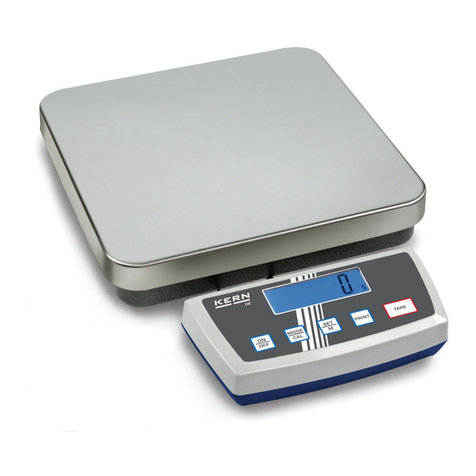
KERN
KERN KERN DE User manual
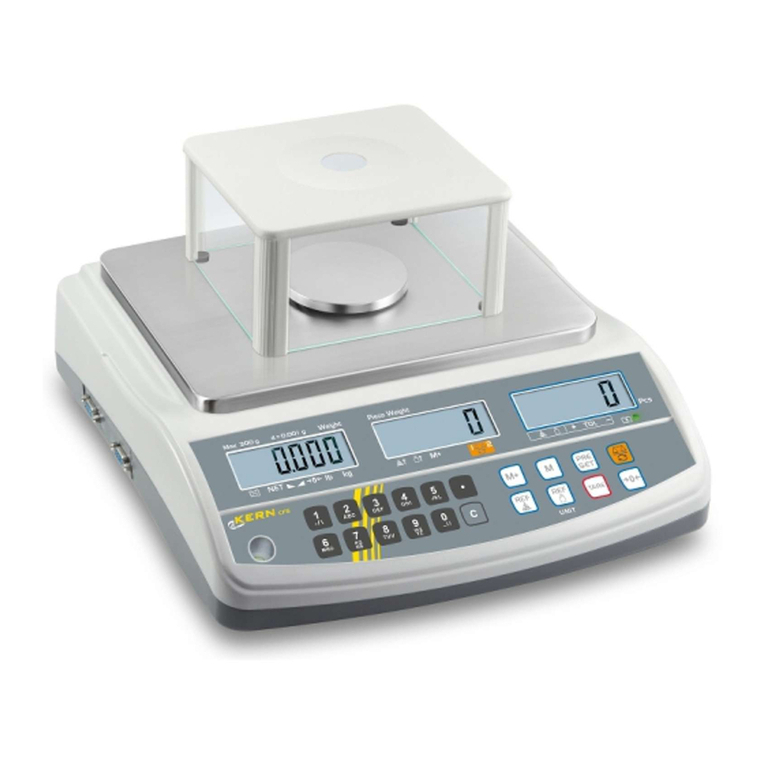
KERN
KERN CCS 6K-6 User manual
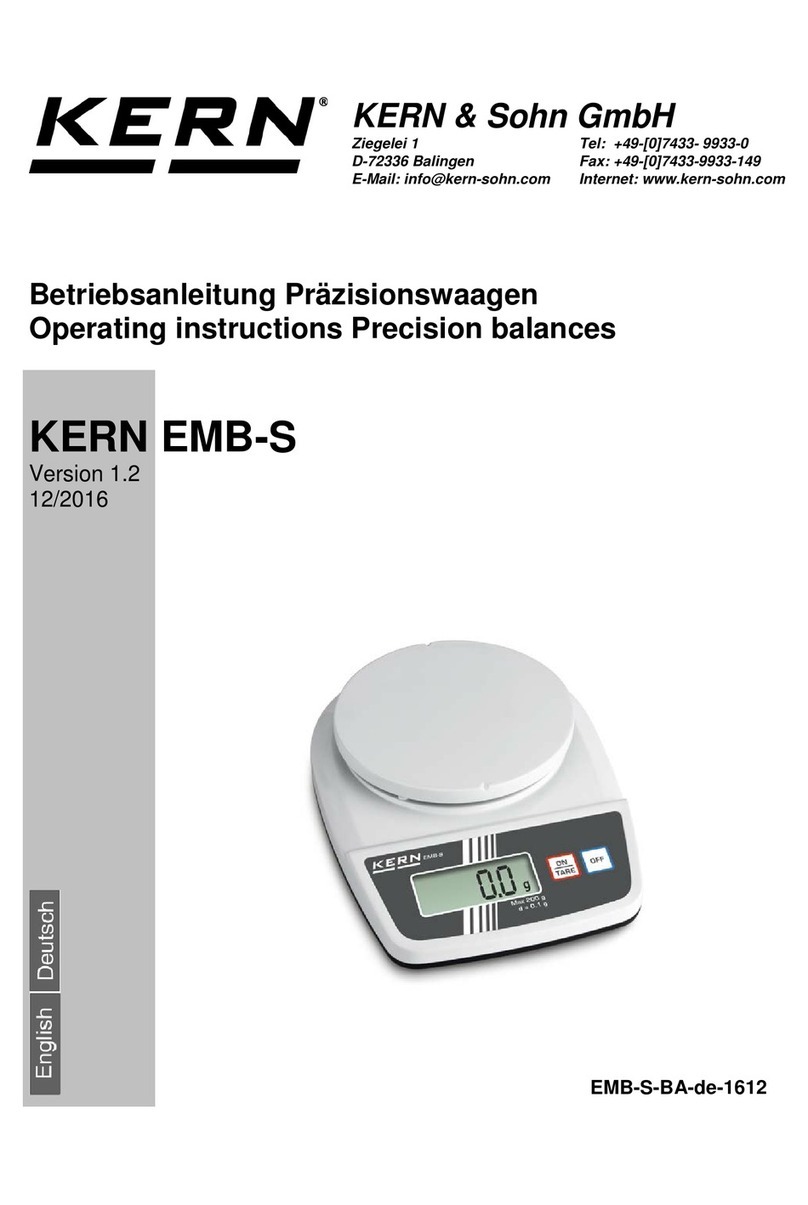
KERN
KERN EMB-S 200-1S User manual
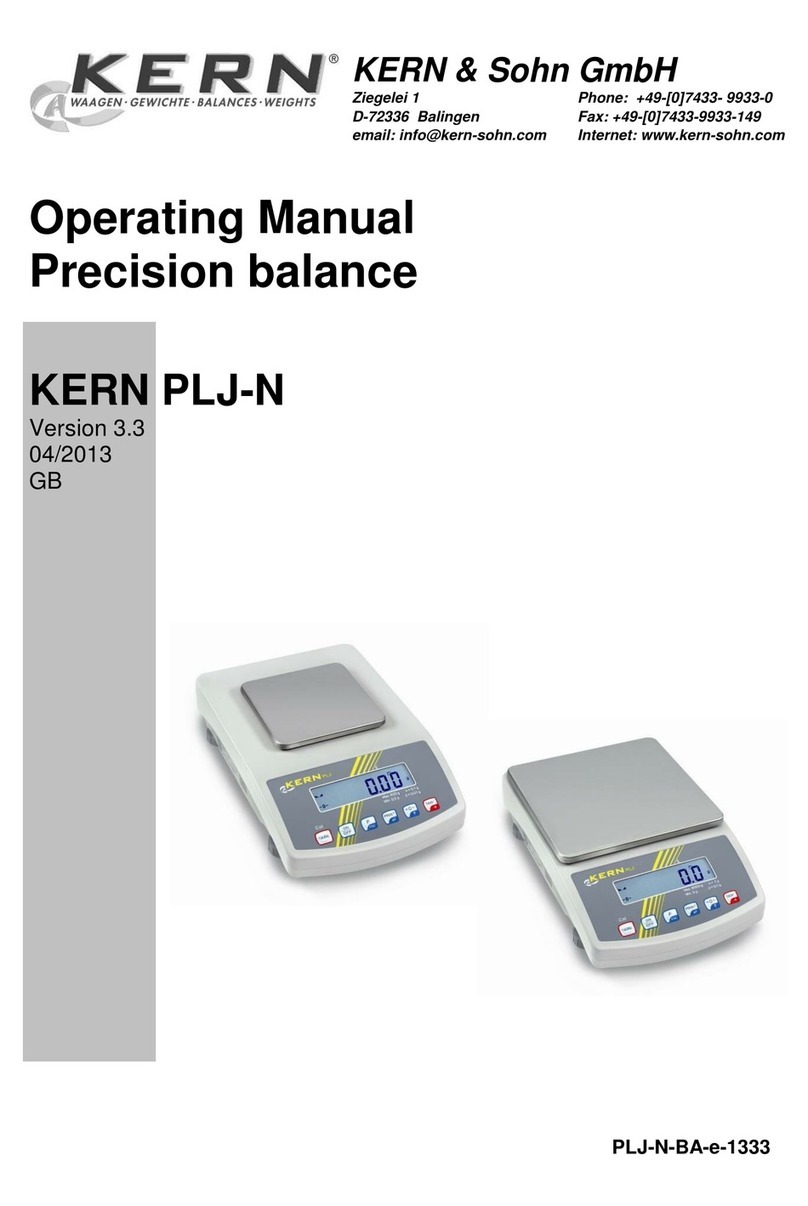
KERN
KERN PLJ-N User manual

KERN
KERN MBE 20K10 User manual
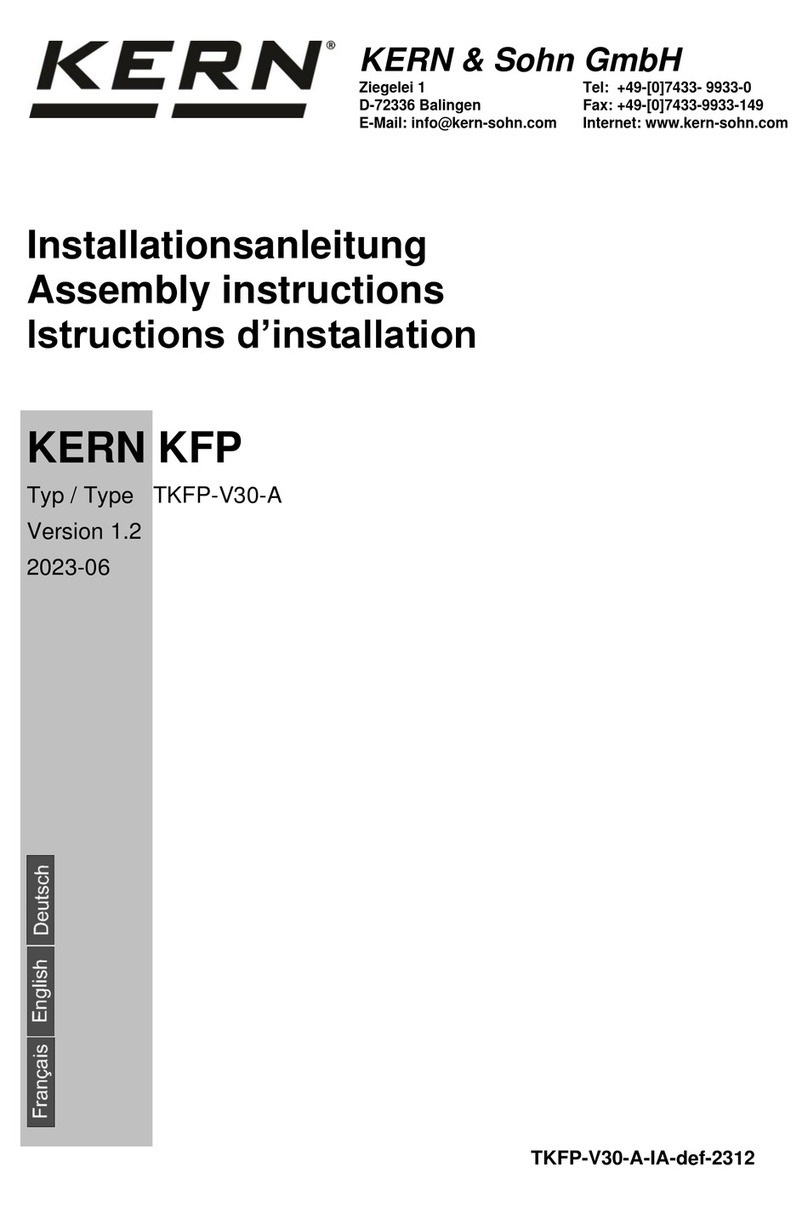
KERN
KERN TKFP 15V30M-A User manual
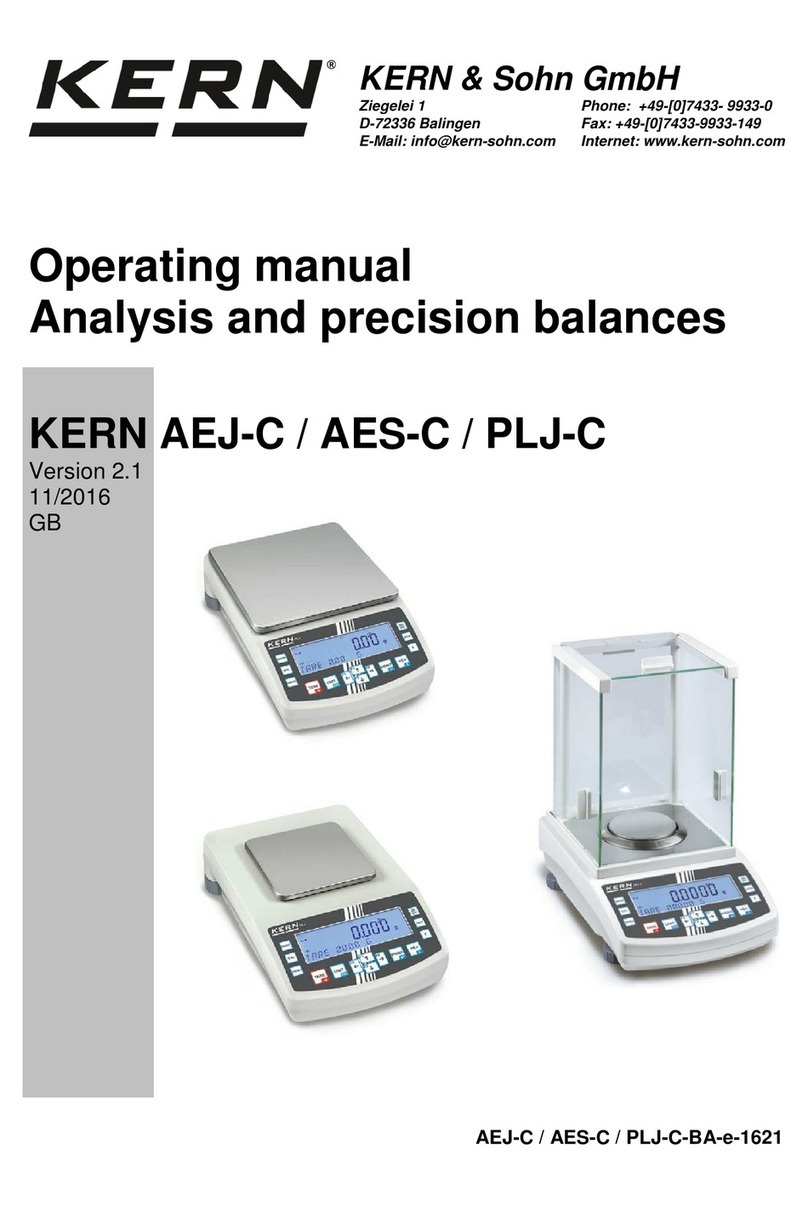
KERN
KERN AEJ-C User manual
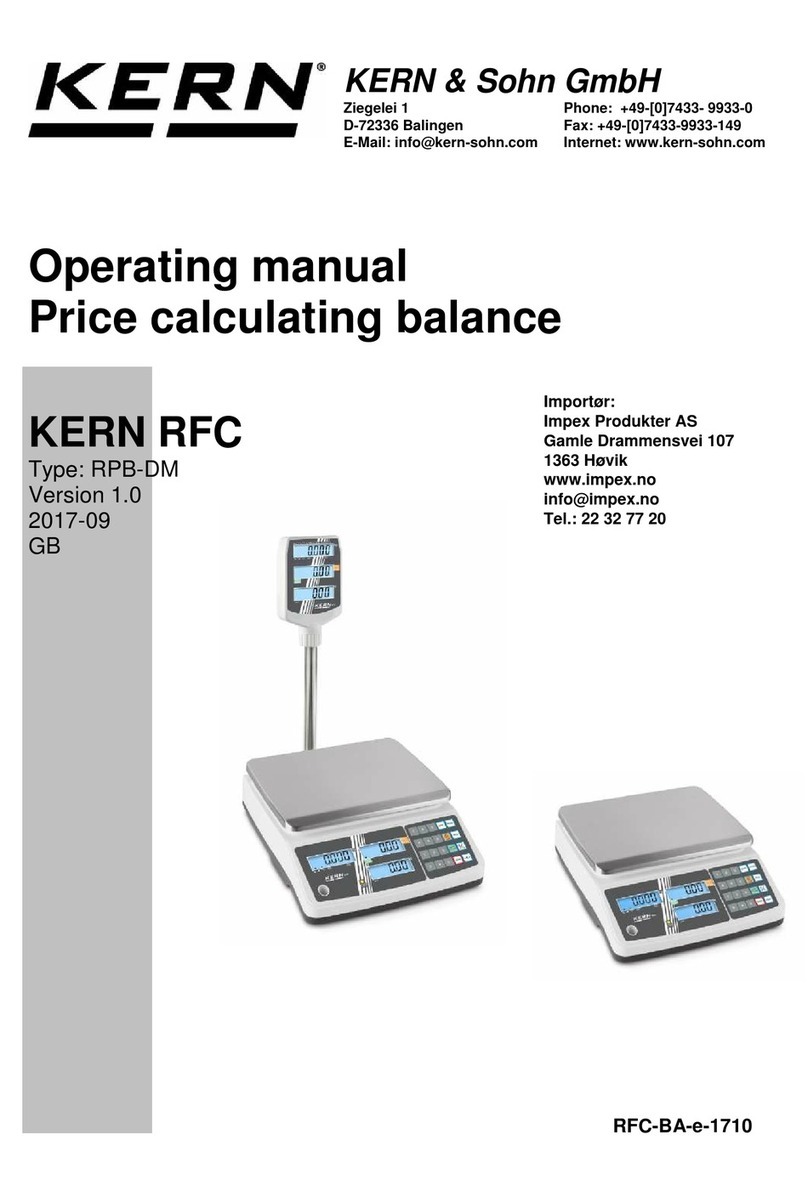
KERN
KERN RFC 6K3M User manual
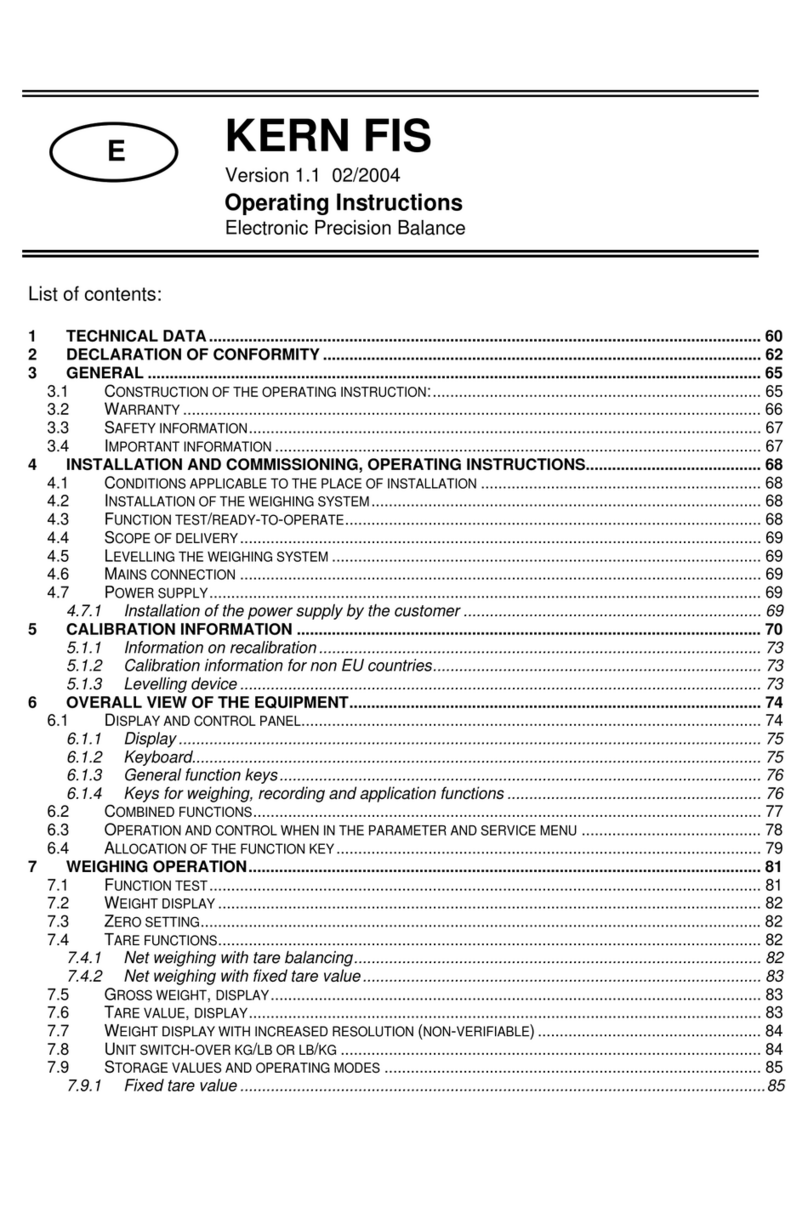
KERN
KERN FIS 120K20 IP User manual

KERN
KERN EMB-S Series User manual
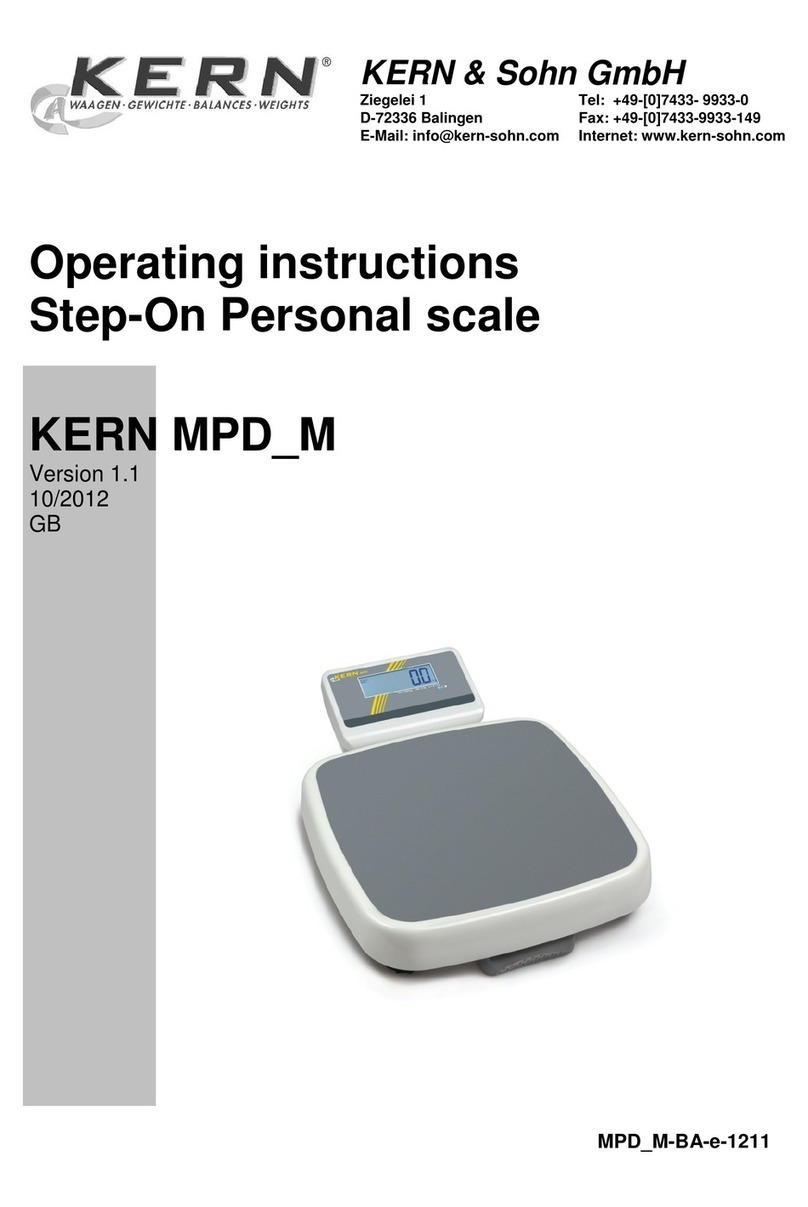
KERN
KERN MPD_M-BA-e-1211 User manual
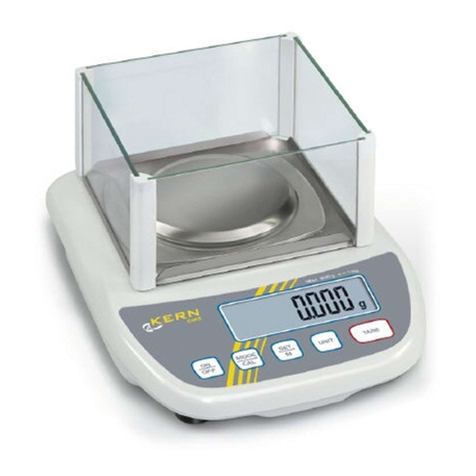
KERN
KERN EMS 300-3 User manual
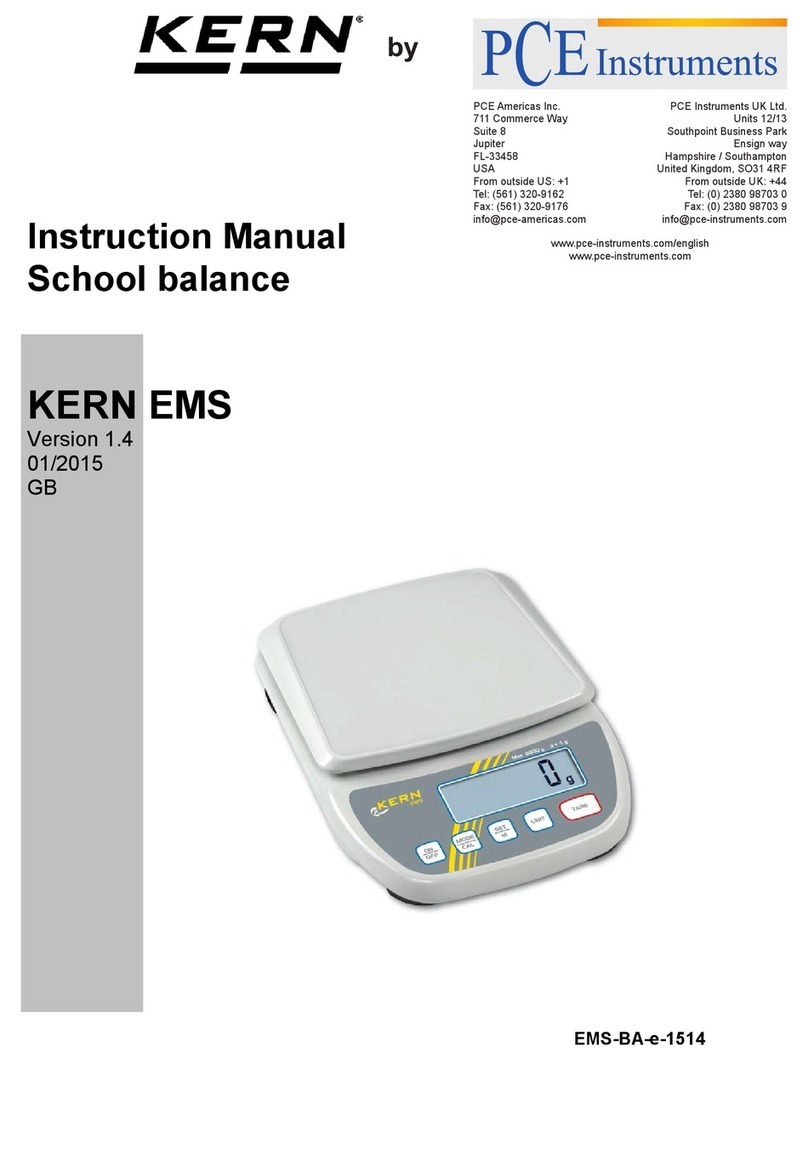
KERN
KERN EMS-BA-e-1514 User manual
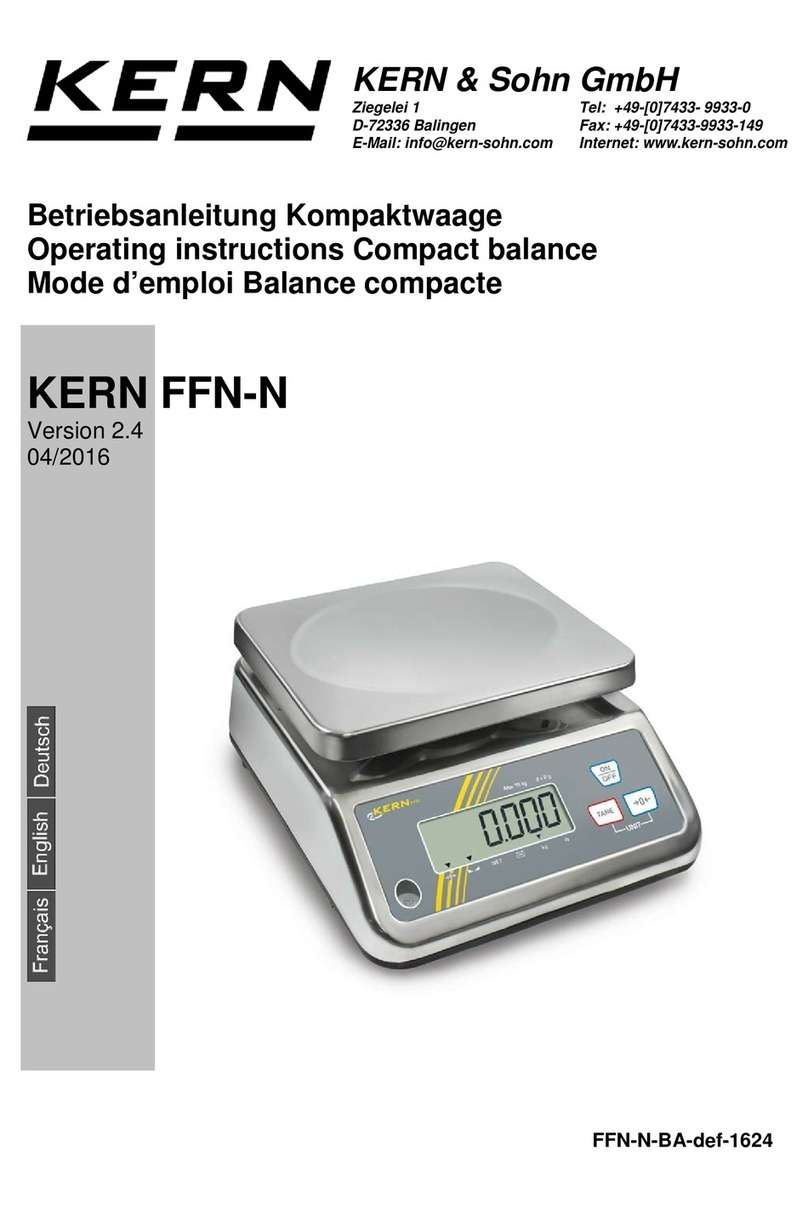
KERN
KERN FFN-N Series User manual
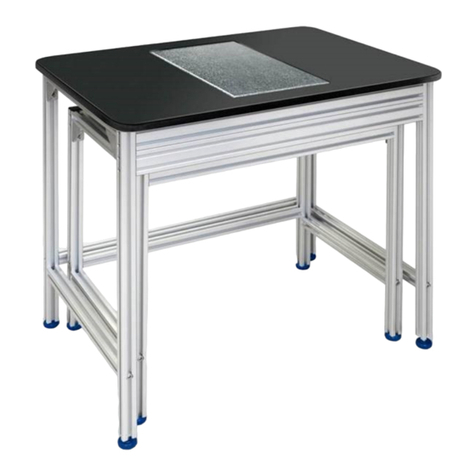
KERN
KERN YPS-03 User manual
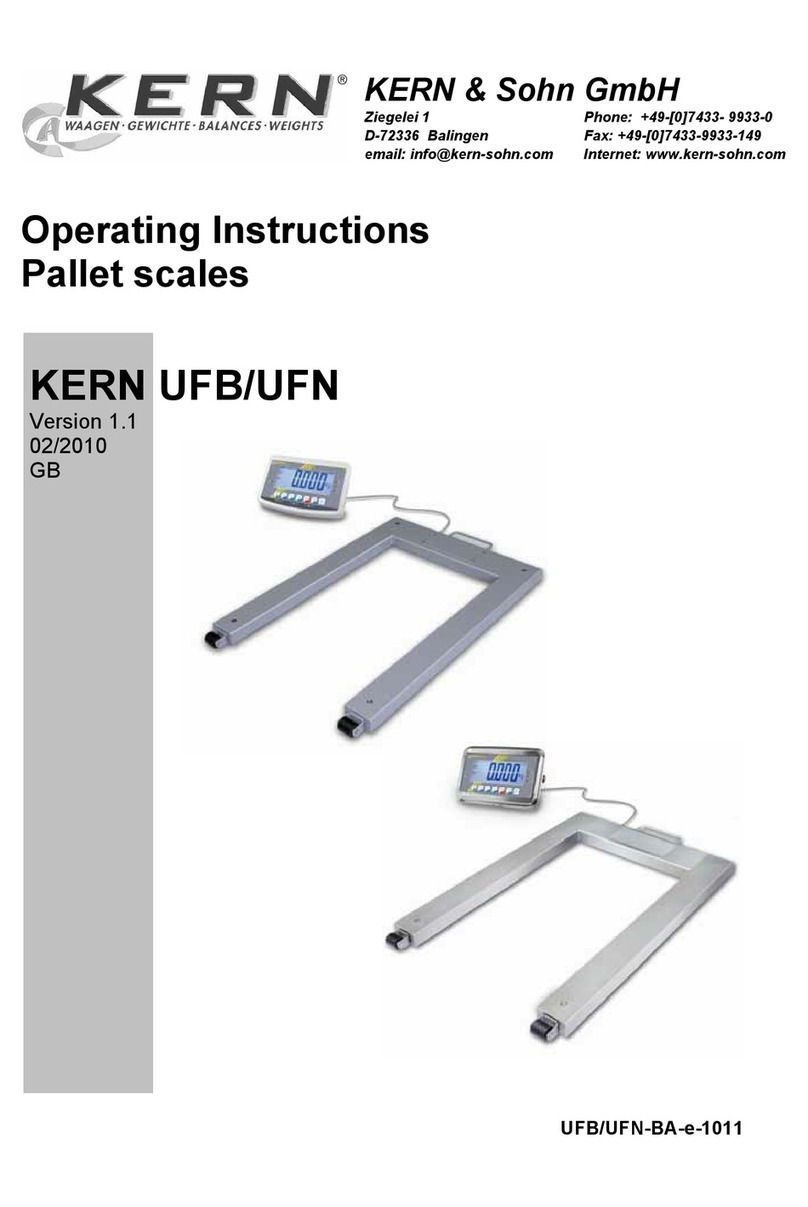
KERN
KERN UFB User manual
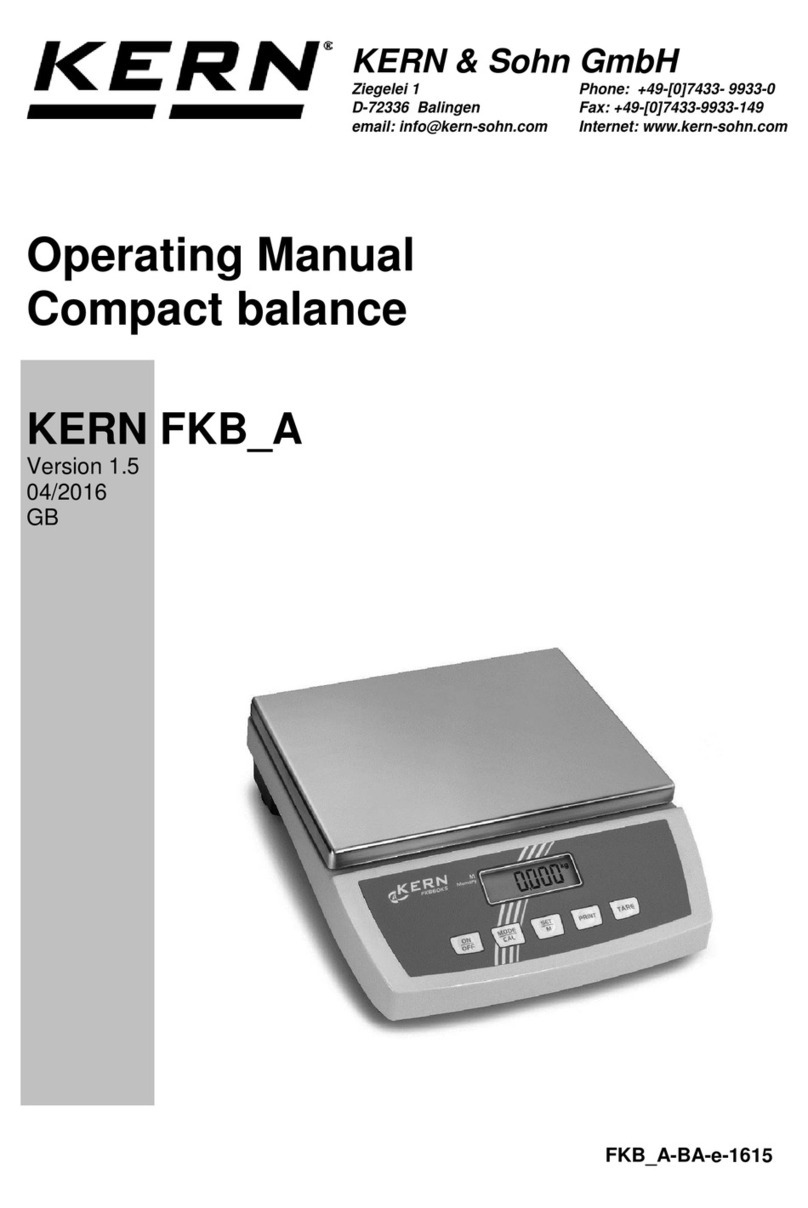
KERN
KERN FKB A Series User manual

KERN
KERN PBJ Series User manual

KERN
KERN AEJ 100-4DM User manual
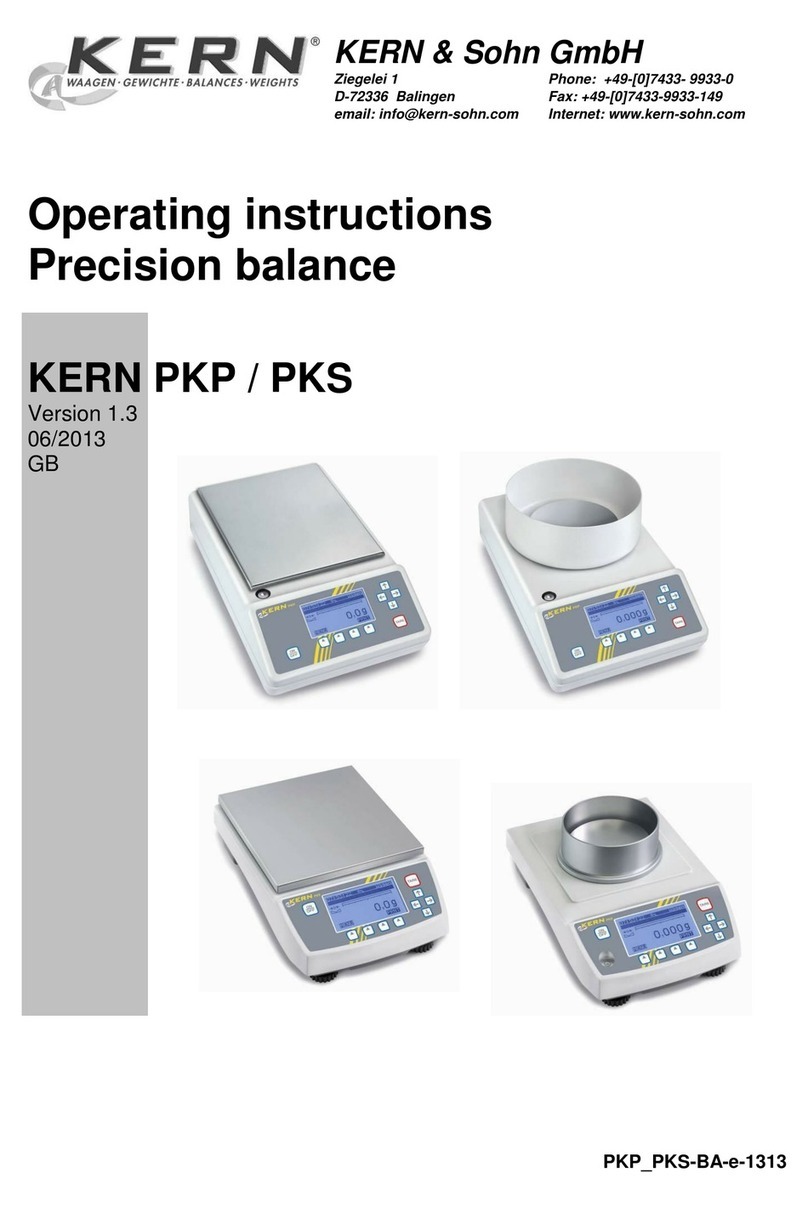
KERN
KERN PKS 200-3 User manual

